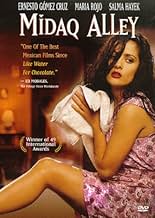IMDb RATING
7.3/10
3.5K
YOUR RATING
The lives of men and women living on Callejón de los Milagros in Mexico City.The lives of men and women living on Callejón de los Milagros in Mexico City.The lives of men and women living on Callejón de los Milagros in Mexico City.
- Awards
- 27 wins & 13 nominations total
- Director
- Writers
- All cast & crew
- Production, box office & more at IMDbPro
Featured reviews
This is a very interesting film. The three stories in the film are connected in some way, and yet not completely connected. The first story explores the issue of homosexuality, which I think is a brave idea in a country that is quite religious. The film is beautifully shot, and the locations seem realistic and reflect the daily life of the people.
My Cable company just recently added the new Spanish HBO to my system. And I just so happen to be flipping through these channels looking for something to watch (you know, it's really late and there is nothing else on), well I came to the Spanish HBO and a movie was just starting with sub-titles. I thought, hey why not. This movie "Midaq Alley" was excellent. It had everything in a movie you could asked for. I recommend this movie highly to everyone, no matter what your ethnic background is - you will walk away from this movie with something. Trust me.
10pilot19
This story demonstrates the intertwined and tragic minutia of common folks told in a dramatic and realistic format. The ensemble cast members are at ease with one another as they display acts of beauty and brutality. The theme of love unfolds from the neophyte, to the jaded, to the unabashed. The actors appear natural and believable (unlike some Latin "novelas"), developing their characters in a seamless and effortless fashion. The devotion to cultural stereotypes only lends credibility to the story's environment and development. The attention to detail (Susanita's teeth for example); make the characters as believable and endearing as any in recent memory. This movie is a brilliant look at human tragedy. Watching it with someone you love only makes it more moving and poignant. Excellent!!!
A film of surprising depth and frankness, this is no Mexican soap opera. The film is told in chapters, one about each major character. They all come from the same neighborhood and their lives intertwine. For the most part the stories wind up in disappointment, with few moments of sweetness, and some real tragedies. It's not quite a slice of life, but compares very favorably to the similar American film Short Cuts by Robert Altman. Without going into too much detail, it follows a late mid-life 'crisis' of a bar owner named Rutilio who finally allows his inner yearnings to surface, almost at the cost of his family. The second chapter follows Alma (Salma Hayek, the only recognizable name from the cast) as a lovely ghetto girl who is torn by the absence of her fiance who is in America and the desires, needs and temptations of being young, lovely, and inexperienced. The third chapter is about Susanna, the local landlord, middle-aged, homely, and never-been-loved and the trials she puts herself through after a fateful tarot-card reading predicting the imminent appearance of a man in her life. The last chapter, the Return, ties all the strings together as best they can be, because this is life and the strings simply don't tie together that well.
I didn't expect a Mexican film of this frankness - not just sex, but characters having real conversations, smoking grass, getting mixed up in an underworld with a sheen of decency and the expected rotten core - all rotating around the table in the neighborhood bar where the men play dominoes. These comments may not have convinced you to see this movie, but if you did see and liked Short Cuts then I highly recommend this film. And if Short Cuts is gobbledegook to you then I recommend both. Nine out of Ten.
I didn't expect a Mexican film of this frankness - not just sex, but characters having real conversations, smoking grass, getting mixed up in an underworld with a sheen of decency and the expected rotten core - all rotating around the table in the neighborhood bar where the men play dominoes. These comments may not have convinced you to see this movie, but if you did see and liked Short Cuts then I highly recommend this film. And if Short Cuts is gobbledegook to you then I recommend both. Nine out of Ten.
The movie Midaq Alley follows different characters to show everyday life for a small community in Mexico while the viewer sees the same story from a different perspective. I think the same scene placed at the beginning of each synopsis that shows some older men playing dominoes in Don Ru's cantina is symbolic because it is representative of an ordinary day and also shows how people in the community gather together and share stories and get to know one another. I feel that it represents the culture in Mexico and emphasizes how everyone looks out for one another, like how Ubaldo looks out for Eusebia's sadness and how Dona Cata looks out for Susanita's feelings, and also how Abel looks out for Chava's well being. By making this scene the establishing shot for each time the viewer sees a different point of view begin, the director is trying to portray how significant gathering for a game of Dominos in the cantina is in the daily lives of those in Midaq Alley. There are also some street scenes where it seems everyone knows one another. I wonder if it is a custom to be so close to neighbors and care for them like family, or if it has to do with the small size of their community. I was not really surprised that the ending was not extremely dramatic. I think it was very fitting to leave things the way they were because the movie was a portrayal of everyday life. I feel that the scenes of the men playing Dominos at Don Ru's cantina are the most important scenes of the film because it tells the viewer that although the characters presented have complex lives, the actions they take to reach their individual happiness are mundane when you take a look at the bigger picture, especially when you realize the men playing dominoes are older and have gone through many life experiences, perhaps they are trying to tell us to relax and not take life so seriously.
Did you know
- TriviaVeronica Falcón's debut.
- ConnectionsFeatured in Cuba mon amour (1997)
- How long is Midaq Alley?Powered by Alexa
Details
- Runtime
- 2h 20m(140 min)
- Color
- Sound mix
- Aspect ratio
- 1.85 : 1
Contribute to this page
Suggest an edit or add missing content


































